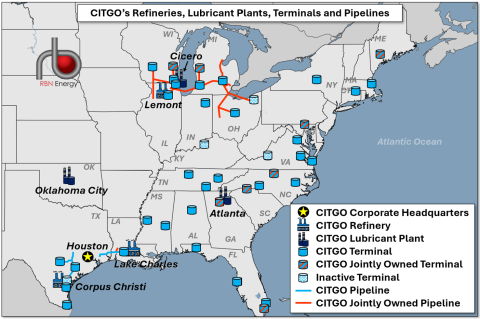The bitter, eight-year battle to control CITGO Petroleum’s three U.S. refineries could soon be coming to an end. A Delaware court has recommended a $7.38 billion bid from Dalinar Energy Corp., the U.S. subsidiary of Canadian miner Gold Reserve Ltd. There’s opposition, but a final decision could be just weeks away. In today’s RBN blog, we’ll discuss what a resolution would mean for the three refineries, which have a combined capacity of more than 800 Mb/d.
Let’s start with some background. As we detailed in I’ll Be Around, there’s been a primarily below-the-radar battle playing out in the U.S. District Court for the District of Delaware since 2017 about how best to help satisfy the claims of a dozen-plus creditors who collectively lost more than $20 billion when the government of Venezuela — the de facto owner of CITGO Petroleum and its parent company, PDV Holding (PDVH) — defaulted on its bonds. (In 2019, control of CITGO was transferred away from the ruling Maduro regime in Venezuela to the opposition “shadow” government, then led by Juan Guaidó.) In May 2021, U.S. District Court Judge Leonard P. Stark appointed Robert B. Pincus as a special master tasked with devising a plan to sell PDVH/CITGO. After a two-round bidding process that concluded in June 2024, Pincus recommended on September 27, 2024, that the district court approve Amber Energy and its $7.3 billion bid for CITGO and its three refineries (Lake Charles, LA; Lemont, IL; and Corpus Christi, TX). However, instead of ending the drama, the court restarted the bidding from scratch in December 2024, citing issues with the auction process.
Figure 1. CITGO’s Refineries, Lubricant Plants, Terminals and Pipelines. Source: CITGO
The winner of the auction will get three impressive U.S. refineries (dark-blue refinery icons in Figure 1 above) in addition to a number of lubricant plants, terminals and pipelines. While we predict there will be refineries shutting their doors in the coming years, we expect all three of the CITGO refineries to be survivors over the next two decades. We also see them benefiting from a variety of market factors we expect to develop, including a modest widening heavy/light crude differential from the record tightness seen so far this year, strong middle distillate margins, and continuing demand for U.S. products in key export markets.
[RBN’s Refined Fuels Analytics (RFA) practice has a deep understanding of the U.S. (and global) refining sector, including the individual companies and refineries that comprise it. For more information on RFA and its areas of expertise, click here. The next edition of our biannual Future of Fuels report will be published later this month.]
Join Backstage Pass to Read Full Article











